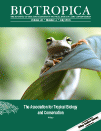Ver ítem
- xmlui.general.dspace_homeCentros e Institutos de InvestigaciónCICVyA. Centro de Investigación en Ciencias Veterinarias y AgronómicasInstituto de BiotecnologíaArtículos científicosxmlui.ArtifactBrowser.ItemViewer.trail
- Inicio
- Centros e Institutos de Investigación
- CICVyA. Centro de Investigación en Ciencias Veterinarias y Agronómicas
- Instituto de Biotecnología
- Artículos científicos
- Ver ítem
The key role of the largest extant Neotropical frugivore (Tapirus terrestris) in promoting admixture of plant genotypes across the landscape
Resumen
The historical and contemporary loss of large-bodied frugivores has disrupted many plant-disperser mutualisms, with potentially profound consequences for plants. Although several aspects of seed dispersal by megafrugivores have already been examined, the role of these species in promoting seed-mediated gene flow has remained unexplored. We evaluated the role of the Amazonian tapir (Tapirus terrestris), the largest Neotropical frugivore, in shaping plant
[ver mas...]
The historical and contemporary loss of large-bodied frugivores has disrupted many plant-disperser mutualisms, with potentially profound consequences for plants. Although several aspects of seed dispersal by megafrugivores have already been examined, the role of these species in promoting seed-mediated gene flow has remained unexplored. We evaluated the role of the Amazonian tapir (Tapirus terrestris), the largest Neotropical frugivore, in shaping plant genetic structure through seed-mediated gene flow. We used microsatellites to analyze the genetic patterns of Syagrus romanzoffiana seedlings recruited in tapir latrines and around conspecific adult palms, the two sites where seeds and seedlings are most frequently found in this species. While the genetic diversity of seedlings was rather similar in both sites, the kinship structure was substantially weaker in latrines. Most seedlings recruited around adult palms were half- or full-sibs originating from those adults. In contrast, seedlings recruited in latrines came from several (>5, on average) contributing mothers other than the nearest adult (95%) and were mostly non-sibs (72%). Kinship patterns indicated that tapir-mediated dispersal promotes the admixture of genotypes across space. Also, our results suggested that genetic diversity and the number of contributing mothers in latrines increase with the number of fruiting adults visited by tapirs before defecating and with the accumulation of feces over time. We provide evidence of the relevance of tapirs in mobilizing maternal progenies (and genotypes) across the landscape and recruiting clusters of unrelated seedlings. This study suggests a key role for plant–megafrugivore interactions in seed-mediated gene flow and emphasizes the importance of preserving such mutualisms
[Cerrar]

Autor
Giombini, Mariano Ignacio;
Bravo, Susana Patricia;
Tosto, Daniela Sandra;
Fuente
Biotropica 48 (4) : 499–508. (July 2016)
Fecha
2016
ISSN
0006-3606 (Print)
1744-7429 (Online)
1744-7429 (Online)
Formato
pdf
Tipo de documento
artículo
Palabras Claves
Derechos de acceso
Restringido
 Excepto donde se diga explicitamente, este item se publica bajo la siguiente descripción: Creative Commons Attribution-NonCommercial-ShareAlike 2.5 Unported (CC BY-NC-SA 2.5)
Excepto donde se diga explicitamente, este item se publica bajo la siguiente descripción: Creative Commons Attribution-NonCommercial-ShareAlike 2.5 Unported (CC BY-NC-SA 2.5)

